Home Decor
Top Designers Reveal Why Indonesian Textiles Are a Must for Modern Homes
Uncover the secrets behind Indonesian textiles and why top designers believe they are essential for modern homes—discover the transformative power they hold.

Indonesian textiles add unmatched character to modern homes while showcasing a rich cultural heritage. Designers love the vibrant colors and intricate patterns that not only beautify your space but also serve as conversation starters. Sustainable practices are essential too, as many artisans use organic materials and traditional methods. This commitment to craftsmanship and eco-friendliness aligns perfectly with today's design trends. Plus, blending these textiles with contemporary decor creates a unique aesthetic that's both inviting and meaningful. Discover how you can incorporate these stunning pieces and enhance your home's ambiance with tales of heritage and artistry.
Key Takeaways
- Indonesian textiles, like batik, combine rich cultural heritage with modern aesthetics, making them ideal for contemporary home decor.
- The vibrant colors and intricate patterns of Indonesian textiles enhance visual appeal and create unique focal points in any space.
- Sustainable practices in textile production align with eco-conscious consumer trends, ensuring environmentally friendly choices without compromising style.
- Incorporating artisan-made textiles supports local craftsmanship and fosters community pride, enriching the narrative of home decor.
- The versatility of Indonesian textiles allows for creative adaptations, seamlessly blending traditional elements with modern designs for a balanced aesthetic.
Historical Significance of Indonesian Textiles

Indonesian textiles, especially batik, hold a rich historical significance that dates back over a millennium. You'll find that batik was once integral to cultural ceremonies and royal courts, symbolizing the deep-rooted traditions of Indonesian society.
This form of Indonesian traditional textile art involves applying hot wax to fabric, creating intricate designs that often carry profound symbolic meanings linked to heritage. Additionally, the art of crafting traditional artistry is reflected in the vibrant colors and unique motifs found in various Indonesian decor masks, showcasing the country's diverse cultural expressions.
In 2009, UNESCO recognized Indonesian batik as an Intangible Cultural Heritage of Humanity, highlighting its global cultural importance. This acknowledgment not only reflects the artistry involved but also showcases the pivotal role batik plays in Indonesian identity.
As you explore the evolution of batik, you'll see how it changed from ceremonial wear to a staple in modern fashion. This adaptability makes it relevant in contemporary lifestyles while still preserving the traditional craftsmanship that defines its essence.
Annual festivals and exhibitions, like "Batik Kita: Dressing in Port Cities," celebrate this rich history, promoting both the heritage and modern adaptations of Indonesian textiles.
Engaging with batik is like connecting with a vibrant narrative that spans centuries, making it a fascinating choice for your modern home.
Modern Interpretations of Batik
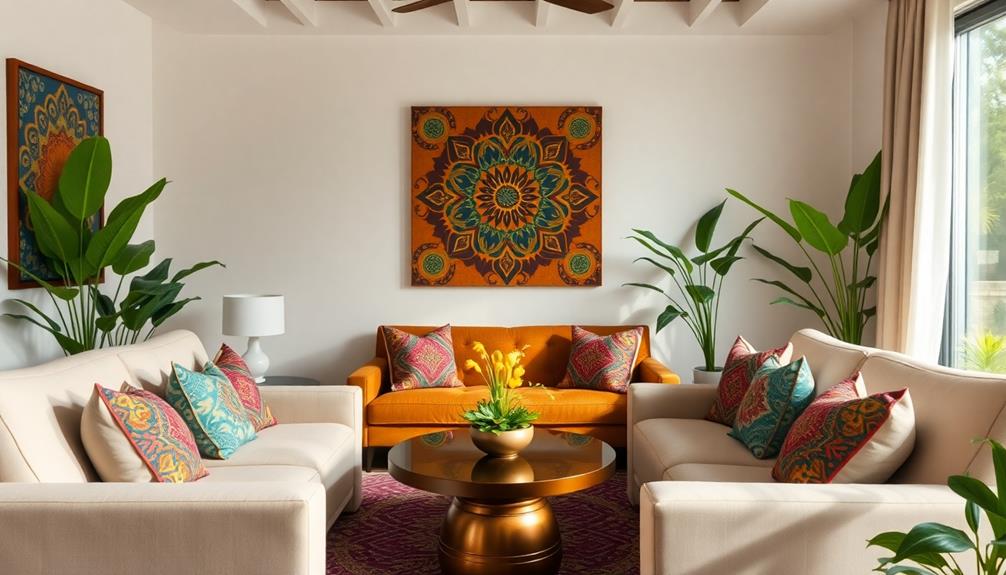
When you explore modern interpretations of batik, you'll notice how contemporary designers merge traditional techniques with fresh, vibrant aesthetics.
This fusion not only revitalizes batik for today's fashion and home decor but also highlights sustainable practices by using organic materials.
Furthermore, these designs often draw inspiration from rich cultural elements, like the Face Indonesian Decor Mask, which adds a unique touch to modern spaces.
As you discover these innovative designs, you'll see how they honor cultural heritage while appealing to a new generation.
Contemporary Batik Designs
Many modern designers are reimagining batik, blending its rich heritage with contemporary aesthetics. Designers like Tan Sheau Yun creatively incorporate traditional elements into chic pieces, such as batik cheongsams, which reflect a fusion of cultures. This evolution has transformed batik from a ceremonial textile into a staple in everyday fashion, showcasing its adaptability to current trends.
The use of vibrant colors and intricate patterns in contemporary batik also mirrors the traditional Indonesian style home decor, enhancing its appeal in modern interiors.
Young designers are essential in revitalizing batik, merging traditional craftsmanship with innovative designs that resonate with younger audiences. Their fresh interpretations keep the essence of batik alive while making it relevant in today's fashion scene.
Plus, the focus on sustainable practices in contemporary batik production emphasizes the importance of responsible fashion. Many artisans are using organic dyes and minimal electricity, ensuring that each piece not only looks good but is also environmentally friendly.
Collaborative initiatives, like those involving the Nanyang Academy of Fine Arts and the Asian Civilisations Museum, further enrich the landscape of contemporary batik. These efforts encourage broader appreciation and understanding of this cultural art form, making it a must-have in modern homes.
Embracing contemporary batik means celebrating both tradition and innovation in your wardrobe.
Cultural Fusion in Fashion
Cultural fusion in fashion has never been more vibrant, with designers creatively blending batik with contemporary styles to produce unique pieces that resonate with diverse audiences. This reimagining of batik celebrates its rich heritage while making it relevant for today's fashion scene.
Modern interpretations, like batik cheongsams, showcase how traditional textiles can be transformed to reflect contemporary aesthetics. The incorporation of Indonesian decorative pillows into home décor also highlights the versatility of batik, allowing it to enhance living spaces with vibrant colors and intricate patterns.
Here are some key elements driving this cultural fusion in batik fashion:
- Innovative Designs: Young designers are experimenting with bold color combinations and fresh silhouettes.
- Cultural Identity: Exhibitions like "Batik Kita" emphasize batik's role in expressing evolving identities in multi-ethnic societies.
- Market Appeal: By appealing to younger generations, batik's market potential is markedly enhanced.
- Sustainability: Designers are prioritizing organic dyes and artisan techniques in batik production to meet the demand for responsible fashion.
- Global Recognition: UNESCO's recognition of batik as an Intangible Cultural Heritage of Humanity has boosted its appreciation and cultural significance.
As you explore modern batik pieces, you'll see how this cultural fusion not only honors tradition but also shapes the future of fashion.
Sustainable Textile Innovations
Sustainable Textile Innovations (Modern Interpretations of Batik)
As designers embrace sustainable textile innovations, modern interpretations of batik are emerging that not only honor traditional practices but also cater to eco-conscious consumers. These contemporary batik pieces often draw inspiration from traditional Indonesian housing, showcasing the rich cultural heritage embedded in their designs.
You'll find that these contemporary batik pieces incorporate eco-friendly materials and sustainable practices, preserving the artistry while appealing to modern sensibilities. Designers are pushing boundaries with innovative designs and vibrant color combinations, enhancing the visual appeal of batik textiles for your home decor.
The adaptability of batik in contemporary fashion reflects a growing interest in responsible fashion, emphasizing artisan-made, non-mass-produced pieces. Young designers play a significant role in reimagining batik, blending traditional techniques with modern aesthetics to create unique textiles that resonate with you and today's consumers.
Moreover, the use of organic dyes and minimal electricity in batik production aligns perfectly with sustainability goals. This showcases the art form's commitment to environmental consciousness, allowing you to make thoughtful choices in your decor.
The Role of Sustainable Practices
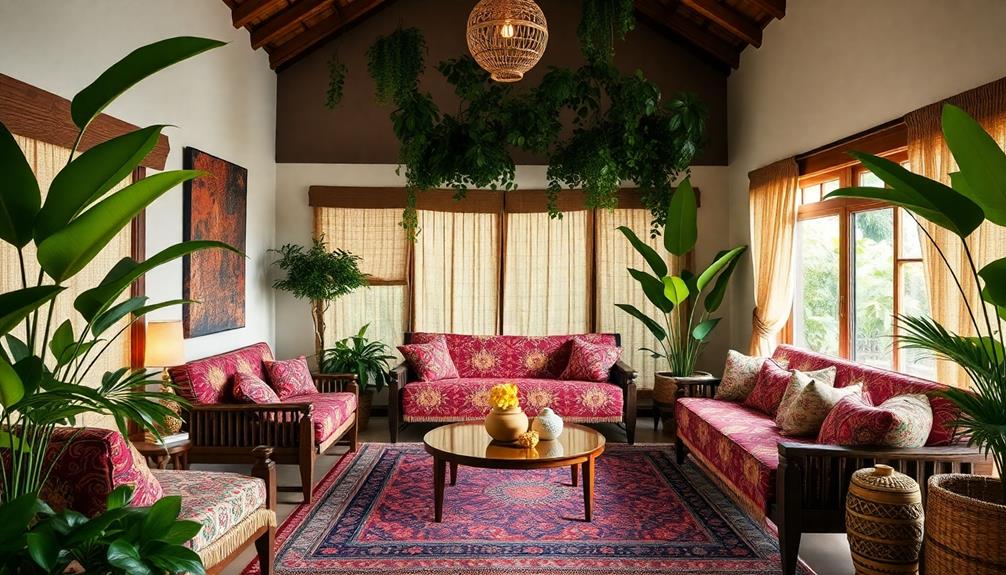
Sustainable practices in Indonesian textile production play a crucial role in preserving not just the environment but also the rich heritage of craftsmanship.
By focusing on artisan-made batik and organic dyes, these practices minimize environmental impact while honoring traditional techniques. The importance of Indonesian decor masks can also be seen in the way they reflect cultural heritage, just as textiles do.
Here's why incorporating sustainable textiles into your home is fundamental:
- Heritage Preservation: Artisan techniques guarantee the continuity of cultural identity and craftsmanship.
- Eco-Friendly Materials: Using natural fibers like cotton and silk aligns with modern design and eco-conscious choices.
- Responsible Consumption: Brands like Nost promote custom-made garments over fast fashion, encouraging thoughtful purchasing decisions.
- Minimal Environmental Footprint: Local resource use and low electricity consumption reduce the overall ecological impact of textile production.
- Skill Development: The intricate process of creating batik stamps nurtures skilled artisans and guarantees the art form's survival for future generations.
Aesthetic Appeal in Interior Design
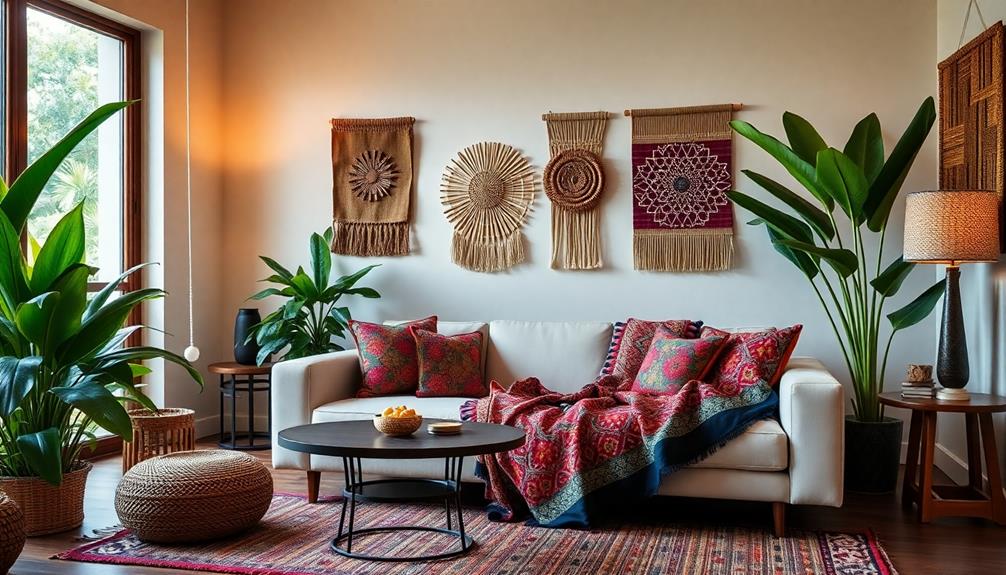
When you incorporate Indonesian textiles into your home, you're not just adding beauty; you're inviting unique cultural narratives into your space.
The textural diversity and warmth of materials like batik and ikat create a cozy atmosphere that resonates with both tradition and modernity. This blend enhances your interior design, making your environment feel richer and more inviting.
Additionally, these textiles can complement the emphasis on natural materials in Balinese design characteristics, creating a harmonious balance between culture and aesthetics.
Unique Cultural Narratives
The allure of Indonesian textiles lies not just in their vibrant colors and intricate patterns, but in the rich cultural narratives they embody. When you incorporate traditional textiles like batik and ikat into your home, you're not just adding beauty; you're inviting a piece of history and heritage into your space.
These textiles resonate with deeper meanings, offering stories that can transform your interior design, much like the embrace of tropical contemporary architecture that harmonizes modern living with natural surroundings.
- Cultural Heritage: Each pattern tells a story, connecting you to Indonesia's diverse roots.
- Artisan Craftsmanship: Handwoven pieces celebrate local artisans, promoting sustainable practices.
- Ambiance Influence: Earthy tones and vibrant colors can enhance tranquility or energy in your home.
- Conversation Starters: Unique designs spark discussions about the cultural significance behind them.
- Modern Blend: The revival of these textiles showcases a beautiful mix of traditional artistry with contemporary trends.
Textural Diversity and Warmth
How can you elevate your home's aesthetic with the rich textural diversity of Indonesian textiles? By incorporating pieces like batik and ikat, you'll instantly enhance your space's warmth and inviting atmosphere.
These textiles aren't just visually appealing; they bring a layer of traditional Indonesian aesthetics that resonates deeply with cultural significance. Additionally, the integration of sustainable practices in design guarantees that your choices contribute positively to both the environment and the local community.
Opting for natural materials in these textiles aligns your design choices with eco-friendly trends, making your decor sustainable. The earthy tones and vibrant colors found in Indonesian textiles create visual interest while promoting a sense of tranquility and connection to heritage.
It's a perfect way to celebrate artistry and craftsmanship in your home. When you integrate local handicrafts, like handwoven textiles, you add character and uniqueness to your interiors.
This fusion of traditional Indonesian textiles with contemporary design fosters a harmonious blend of cultural heritage and modern aesthetics. Ultimately, these textiles enrich your home's ambiance, making it not just a living space but a canvas that tells a story.
Embrace the textural diversity of Indonesian textiles, and watch your home transform into a warm, inviting sanctuary.
Cultural Connection Through Textiles

Indonesian textiles, like batik and ikat, connect you to a vibrant cultural heritage that resonates deeply with identity and craftsmanship. Incorporating these textiles can also enhance your event decor, as seen in various Indonesian wedding decor ideas, creating a unique atmosphere that reflects traditional artistry.
Each piece serves not just as decor but as a storytelling medium, reflecting the rich history and diverse communities of Indonesia. By incorporating these traditional textiles into your modern home, you create a unique blend of past and present that speaks volumes.
Here are a few reasons why these textiles are essential:
- Cultural Significance: Each design often tells a story, connecting you to the traditions of the artisans who create them.
- Artisan Support: Purchasing these textiles helps sustain local craftsmanship and promotes fair trade practices.
- Sustainable Practices: Many artisans use eco-friendly methods, aligning with your values for a sustainable lifestyle.
- Aesthetic Appeal: The intricate patterns and vibrant colors enhance the visual appeal of any space.
- Emotional Resonance: These textiles can evoke memories and feelings, creating a warm, inviting atmosphere in your home.
Innovations by Emerging Designers
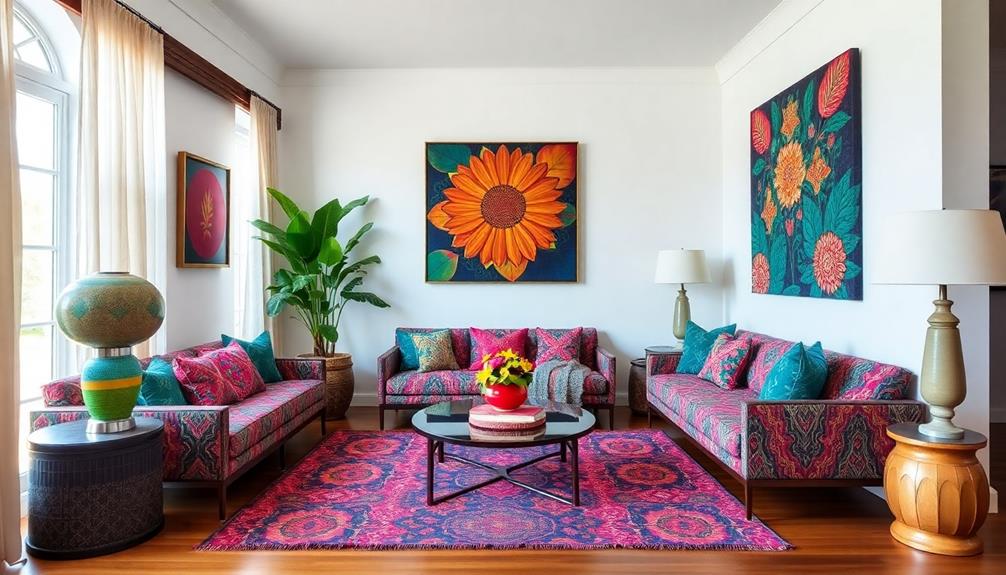
Emerging designers are breathing new life into traditional Indonesian textiles by weaving them into modern home decor. These innovative creators are taking beloved fabrics like batik and ikat and reimagining them for today's aesthetic, blending cultural heritage with contemporary style.
Their collections often emphasize eco-friendly materials and sustainable practices, showcasing a commitment to both the environment and the rich history of heritage textiles.
You'll find that these designers are experimenting with unexpected color combinations and patterns inspired by nature, resulting in unique pieces that resonate with modern consumers.
Collaborations with local artisans play an essential role, as they preserve traditional crafting techniques while introducing these textiles to a broader audience. This fusion not only enhances the aesthetic appeal of your home but also fosters a deeper appreciation for the cultural narratives and craftsmanship behind each piece.
As you explore these innovations, you'll discover how traditional Indonesian textiles can add a fresh perspective to your decor, making your space not just stylish but also rich in story and significance.
Embracing these designs allows you to celebrate both art and culture in your modern home.
Incorporating Textiles in Home Decor

Incorporating textiles into your home decor can transform your space, adding a unique character that celebrates rich artistry and cultural significance.
Traditional Indonesian fabrics like batik and ikat not only enhance the beauty of your interiors but also tell a story of heritage and craftsmanship.
Here are some ways to effectively integrate these textiles into your home:
- Accent Pillows: Use vibrant batik-covered cushions on sofas to inject color and comfort.
- Table Runners: Place an ikat table runner on your dining table for a stunning focal point during meals.
- Wall Hangings: Hang large pieces of traditional fabric as art to showcase intricate patterns and designs.
- Throw Blankets: Drape a handwoven throw over a chair for warmth and a touch of elegance.
- Curtains: Choose lightweight Indonesian fabrics for curtains that filter light beautifully while adding texture.
Balancing Tradition and Modernity
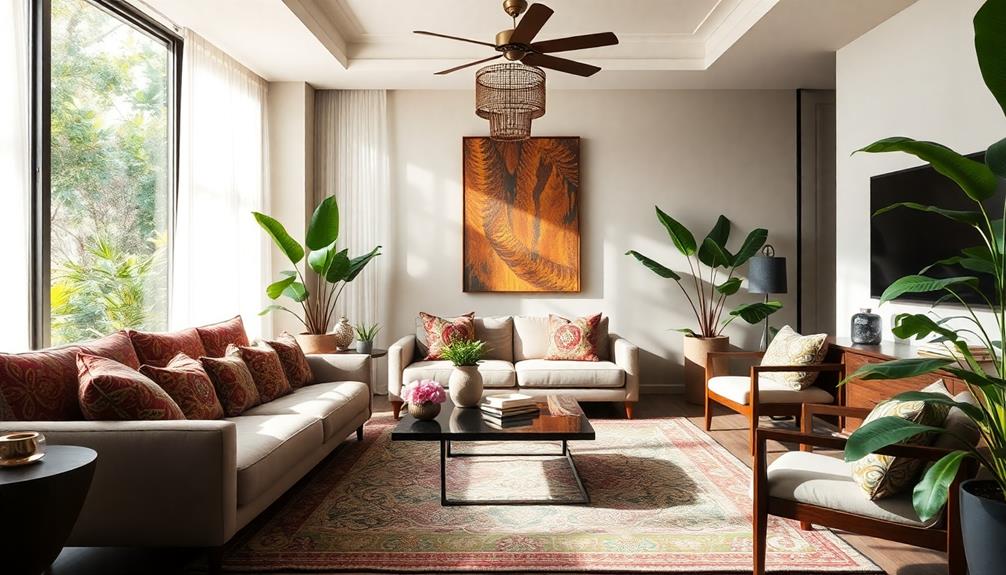
Bringing traditional Indonesian textiles into your home decor doesn't just celebrate artistry; it also sparks a fascinating conversation between history and modern design. By incorporating pieces like batik, you can embrace the rich cultural heritage of Indonesia while making it relevant to contemporary aesthetics.
These textiles embody Indonesian identity and showcase how traditional patterns can blend seamlessly with modern interior styles. Designers are reinterpreting these textiles, allowing them to thrive in today's homes without losing their significance.
You'll find that the vibrant colors and intricate designs enhance your space, creating a unique atmosphere that reflects both heritage and modern taste. This balance is vital, as it honors the artistry of local artisans while promoting sustainable practices.
Collaborations between contemporary designers and local artisans play a significant role in this process. They guarantee that the craftsmanship behind Indonesian textiles isn't only preserved but also innovated, making these fabrics a staple in modern decor.
Future Trends in Textile Use

As we look ahead, the use of traditional Indonesian textiles in home decor is evolving, reflecting a blend of cultural appreciation and modern design sensibilities.
Designers are now producing creations that merge the beauty of batik and ikat with contemporary aesthetics, making these textiles more relevant than ever.
Here are some future trends to watch:
- Cultural Fusion: Expect to see more combinations of Indonesian textiles with other global styles, creating unique, eclectic looks.
- Sustainable Choices: The demand for eco-friendly, artisan-made textiles is rising, as consumers prioritize sustainability in their purchases.
- Everyday Versatility: Contemporary adaptations of traditional textiles are becoming popular, allowing you to use them in a variety of settings.
- Biophilic Design: A focus on natural materials connects interiors to nature, highlighting the organic beauty of Indonesian textiles.
- Heritage Appreciation: Designers are showcasing the craftsmanship and stories behind these textiles, adding depth and narrative to your decor.
Frequently Asked Questions
What Types of Indonesian Textiles Are Most Popular for Home Decor?
When decorating your home, you'll love the vibrant batik, intricate ikat, and soft tenun textiles. These fabrics bring warmth and character, making your space feel more inviting and unique with their rich cultural heritage.
How Can I Care for and Maintain Indonesian Textiles?
When it comes to caring for Indonesian textiles, you've gotta treat them like a precious gem. Regularly dust and vacuum, spot clean stains, and avoid direct sunlight to keep their vibrant colors shining bright.
Where Can I Purchase Authentic Indonesian Textiles?
You can purchase authentic Indonesian textiles at specialized boutiques, local artisan markets, or online platforms like Etsy and Fair Trade websites. Make sure to verify the seller's credentials for genuine products and quality assurance.
Are There Specific Color Schemes That Complement Indonesian Textiles?
Indonesian textiles are a vibrant explosion of color! To complement them, you'll love earthy tones like terracotta or deep greens, which enhance their richness. Pair with soft neutrals for balance, creating a stunning visual harmony.
Can Indonesian Textiles Be Used in Outdoor Spaces?
Absolutely, you can use Indonesian textiles in outdoor spaces! Their vibrant colors and unique patterns add a lively touch. Just guarantee you choose weather-resistant fabrics to maintain their beauty and durability in various outdoor conditions.
Conclusion
Incorporating Indonesian textiles into your home not only enhances its beauty but also connects you to a rich cultural heritage. Did you know that the global market for sustainable textiles is expected to reach $8.25 billion by 2027? This statistic highlights the growing appreciation for eco-friendly designs, making now the perfect time to embrace these vibrant fabrics. By blending tradition with modern aesthetics, you can create a space that's both stylish and meaningful.
Home Decor
Discover the Batik Patterns That Will Add Depth to Any Space
Open your eyes to the vibrant world of batik patterns that can transform your space into a masterpiece—discover the possibilities that await!
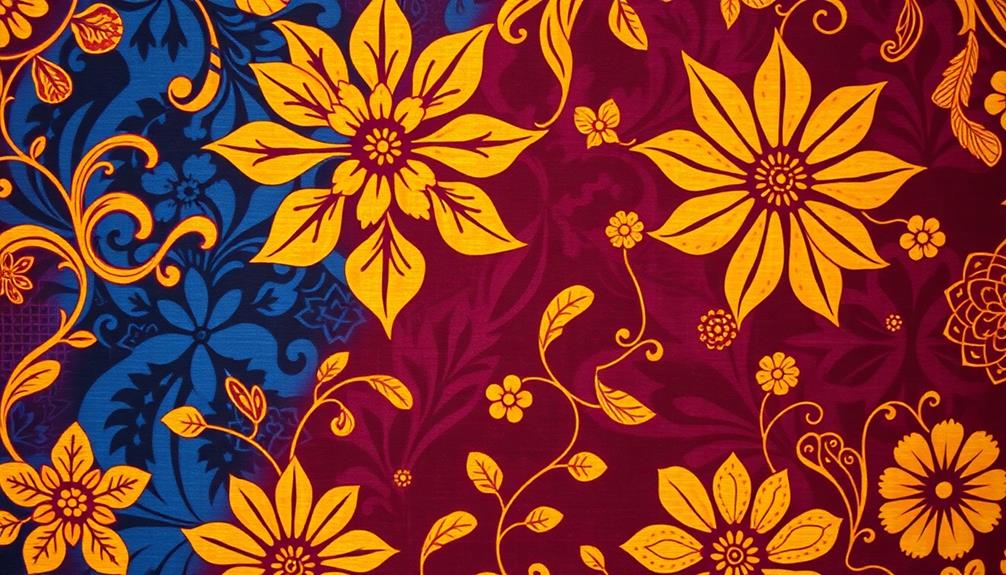
Batik patterns are a fantastic way to infuse vibrancy and depth into your space. Originating from Javanese culture, these intricate designs feature rich colors and unique motifs, each with its significance. You'll find styles like Batik Tulis, hand-drawn for a personal touch, or Batik Cap, stamped for ease. Whether you choose decorative cushions, bold wall art, or vibrant table runners, batik adds character and a sense of history to your decor. This creative flexibility complements various design styles while offering a unique, artistic flair. Stick around to explore even more stylish batik options that can transform your home!
Key Takeaways
- Batik patterns, rooted in Javanese culture, showcase intricate artistry that adds historical richness to any decor.
- Vibrant designs, such as the Color Flow and Juxtaposition quilts, create stunning visual contrasts in living spaces.
- Unique, handmade batik pieces serve as focal points, enhancing artistic expression and personalization in interior design.
- Seasonal batik patterns, like Snow Crystals, introduce festive themes while showcasing craftsmanship, perfect for holiday decor.
- Incorporating batik textiles elevates home decor, providing a personal touch and fostering cultural appreciation in various settings.
Understanding Batik Patterns

When you immerse yourself in the world of batik patterns, you uncover a rich tapestry of artistry and culture. Traditional batik originated from the Javanese tradition, where artisans employ intricate batik techniques to create stunning designs. This craft involves applying hot wax onto fabric, which resists dye, resulting in vibrant, unique patterns that tell stories through their motifs.
Additionally, batik patterns often share similarities with traditional Indonesian decor masks, as both celebrate the rich cultural heritage of Indonesia through vibrant artistry and storytelling traditional artistry.
You'll find different types of batik, such as Batik Tulis, which is hand-drawn, and Batik Cap, which is stamped. Each method offers varying levels of detail, showcasing the skill of the maker. The batik motifs you encounter often carry significant cultural meanings; for instance, certain colors and designs can denote social status or convey specific messages within Indonesian culture.
When you consider incorporating batik into your home decor or fashion choices, you're not just adding beauty; you're also embracing a piece of history. The versatility of batik allows it to enhance any space, blending historical richness with modern artistic expression.
Seaside and Coastal Inspirations

Batik patterns inspired by the seaside can transform your space into a tranquil coastal retreat. Imagine the soothing blues and greens reminiscent of ocean waves dancing across your walls or furniture.
Incorporating Indonesian Decorative Pillows with vibrant batik designs can further enhance the coastal vibe, adding comfort and cultural heritage to your decor. Batik fabrics featuring designs like the Seaside Steps quilt, with its Courthouse Steps blocks in fresh, cool tones, evoke that nautical feel perfect for coastal decor.
Another stunning option is the Batak Ocean Waves quilt, which incorporates gold triangles that create playful pinwheels within the Ocean Waves blocks. The combination of blue and cream batiks adds a sense of movement, making your space feel alive and inviting.
For a more modern touch, the Beachy Waves quilt showcases a bargello style that mimics actual ocean waves, using a palette of sea glass colors. This creates a soothing ambiance ideal for beach houses or any coastal-inspired room.
All these batik designs not only celebrate the beauty of traditional motifs but also bring a revitalizing atmosphere into your living spaces.
Plus, they're available as free downloads, allowing you to easily enhance your home decor with seaside charm.
Seasonal and Holiday Themes
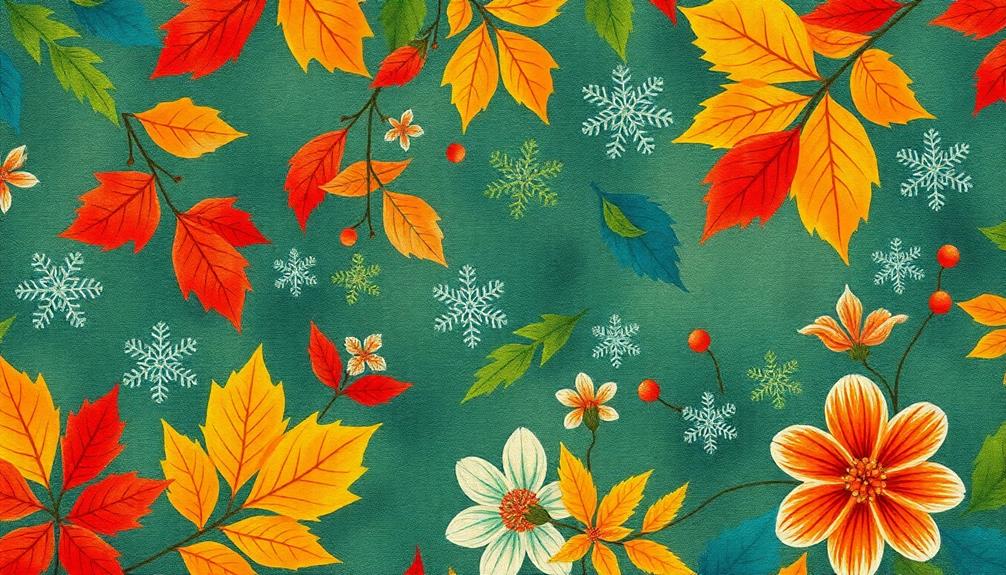
Celebration comes alive with seasonal and holiday-themed batik patterns that bring joy and warmth to any space. These patterns, like Snow Crystals, capture the essence of winter with cool colors, perfect for seasonal decor and striking wall hangings. The Patriotic Patches pattern features vibrant red squares alongside serene blue and white strips, making it an ideal choice for patriotic celebrations.
Incorporating seasonal batik designs into your home not only adds a festive touch but also showcases the unique artistry and craftsmanship of batik textiles. Many seasonal batik quilts come with free patterns available for download, allowing you to easily integrate these stunning designs into your holiday decor.
| Pattern Name | Best For |
|---|---|
| Snow Crystals | Winter decor |
| Patriotic Patches | Independence Day |
| Seasonal Quilts | Year-round celebrations |
Using batik fabrics enhances the visual appeal, creating a vibrant atmosphere during celebrations. Whether you're hosting a gathering or simply want to add a touch of warmth, these seasonal batik patterns are sure to make your space feel festive and inviting.
Vibrant and Colorful Designs
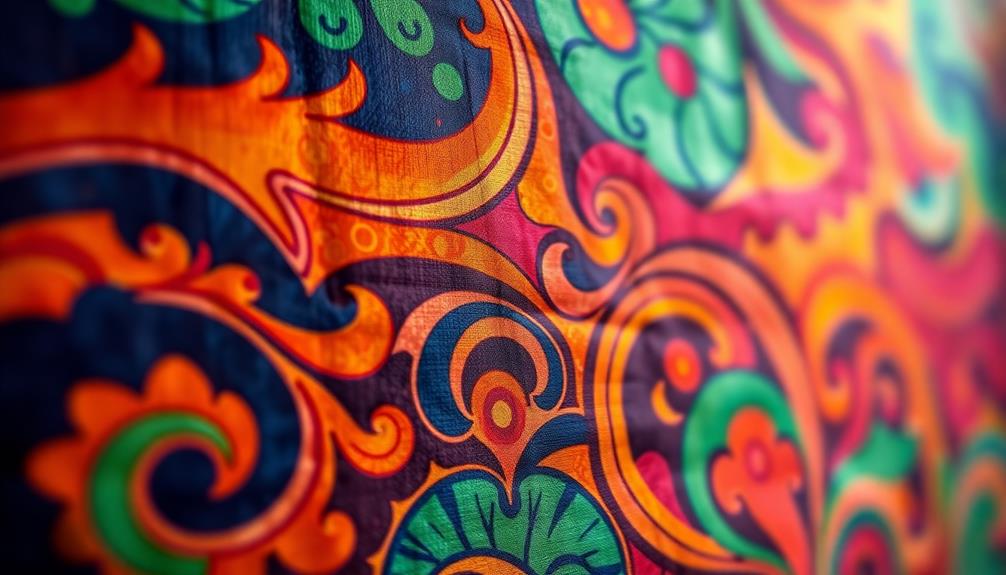
Amidst the world of interior design, vibrant and colorful batik patterns effortlessly alter any space into a visual feast. You'll find that traditional Indonesian batik, with its rich history, showcases vibrant designs that breathe life into your home.
Consider the Juxtaposition quilt, featuring jewel tones that create stunning contrasts, perfect for cozy settings. Or take a look at Color Flow, which presents an enchanting rainbow effect, shifting from hot to cool colors set against a bold black background—ideal for striking wall decor. These batik patterns, much like the unique artistic expressions found in Indonesian decor masks, highlight the beauty of traditional craftsmanship.
The Batik Jewels Throw offers large triangle-square units in elegant jewel tones, creating a diagonal-stripe effect that enhances any living space. Each of these vibrant designs not only highlights the intricate craftsmanship of batik textile art but also invites you to explore your creativity.
Free quilt patterns are available for download, making it easier than ever to incorporate these modern motifs into your decor.
With these colorful batik patterns, your space will reflect both style and personality, turning it into a warm and inviting haven that celebrates the beauty of batik.
Unique and Artistic Patterns
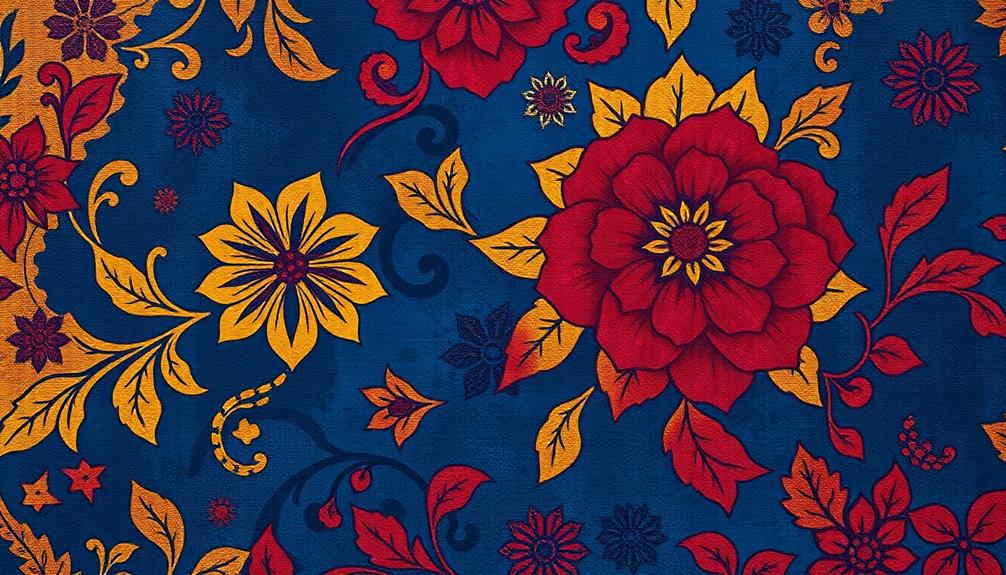
When you explore unique batik patterns, you'll discover a world of artistic expression waiting to be released. Each design, inspired by various themes and styles, invites you to interpret and personalize it in your own way.
These patterns not only enhance the aesthetic appeal of your space but also reflect the rich cultural heritage of Indonesia, much like the intricately designed Indonesian decor masks that tell stories through their craftsmanship.
Whether it's the intricate Tile Style or the subtle Wild Triangle-Squares, these patterns transform any space into a creative haven.
Artistic Expression in Batik
Batik patterns offer a vibrant canvas for artistic expression, inviting you to explore unique designs that transform any space. You can experience the beauty of batik cloth through various batik creations, each reflecting the intricate techniques of ancient Javanese artistry.
Incorporating batik into your decor aligns beautifully with traditional Indonesian style home decor, emphasizing harmony with nature and showcasing local culture. Using batik allows you to showcase your creativity, whether through a complex batik throw inspired by tiled auditorium floors or a subtle Wild Triangle-Squares wall hanging that captures a unique watercolor effect.
The Batik Jewels Throw demonstrates elegance with large triangle-square units that create a striking diagonal-stripe effect, perfect for cozy living areas. Each hand-drawn batik piece emphasizes vibrant colors and detailed patterns, encouraging you to express your artistry and elevate your decor.
The intricate wax-resist dyeing techniques contribute to the uniqueness of each pattern, making them ideal for those seeking depth and character.
Unique Design Inspirations
Adding batik to your decor opens up a world of unique design inspirations that can elevate your space. Consider the Tile Style batik throw, inspired by tiled auditorium floors, which showcases intricate patterns and encourages your artistic expression. This piece, with its complex designs, can be an eye-catching addition to your living room or bedroom, creating a stunning batik wall.
Additionally, incorporating traditional motifs and patterns can enhance the cultural significance of your decor.
For those drawn to nature, the Wild Triangle-Squares Wall Hanging offers a safari theme with subtle, watercolor effects. The limited contrast in batiks allows the rich dark blue hues to blend beautifully, making it perfect for a serene and inviting atmosphere.
Both of these unique batik designs not only serve as focal points but also enhance the visual appeal of your interiors. The batik industry produces an array of options, from vibrant silk batik to more muted pieces, allowing you to find the perfect match for your style.
Incorporating Batik in Home Decor

Transforming your home into a vibrant sanctuary can be easily achieved through the incorporation of batik fabrics. These textiles, renowned for their intricate designs and vibrant colors, can elevate your home decor in various ways.
Batik's unique patterns can complement the calming earth tones and natural materials often seen in Balinese interior design concepts. You can effortlessly incorporate batik, whether it's Batik Tulis or stamped batik, to create a unique artistic atmosphere.
Here are some creative ideas for using batik in your space:
- Cushions and Throws: Add colorful batik cushions and throws to your living room for an instant pop of color.
- Wall Art: Hang framed batik panels as bold statement pieces that reflect cultural significance and craftsmanship.
- Table Runners: Use batik table runners or placemats to enhance your dining experience, bringing warmth and style to your meals.
The versatility of batik allows it to blend seamlessly into various design styles, from traditional to modern.
Plus, the handmade nature of these fabrics guarantees that each piece is unique, giving your home decor an authentic and personal touch that mass-produced items simply can't match.
Embrace batik and watch your space come alive!
Frequently Asked Questions
What Are the Patterns of Batik?
Batik patterns vary widely, including intricate hand-drawn designs, stamped motifs, and painted styles. Each offers unique artistic expressions, reflecting cultural significance and vibrant colors influenced by regional traditions and modern interpretations. You'll appreciate their beauty!
What Are the 5 Major Types of Batik Design?
When exploring batik designs, you'll encounter five major types: Batik Tulis, Batik Cap, Batik Lukis, Batik Pesisir, and Batik Belanda. Each offers unique techniques and styles, showcasing Indonesia's rich cultural heritage and artistic expressions.
What Is the Most Famous Batik Pattern?
Did you know that the "Kawung" pattern is one of the most famous batik designs? Its geometric coconut symbol holds deep cultural significance in Javanese society, representing both beauty and tradition. You'll love its intricate elegance!
What Are the Three Main Elements of Batik Pattern?
The three main elements of batik patterns are the base fabric, wax application, and dye baths. You'll see how these components work together to create vibrant, intricate designs that reflect cultural significance and artistic expression.
Conclusion
Incorporating batik patterns into your home decor is like adding a splash of color to a black-and-white canvas. These vibrant designs can transform any space, imbuing it with personality and warmth. Whether you opt for seaside motifs, seasonal themes, or unique artistic prints, you'll create an inviting atmosphere that reflects your style. So go ahead, embrace the beauty of batik and watch your home come alive with depth and character!
Home Decor
Batik: The Cultural Design Element You’re Missing in Your Home
Not only does Batik enhance your home decor, but it also connects you to a rich cultural narrative waiting to be explored.

Batik isn't just a beautiful textile; it's a piece of rich cultural heritage you're missing in your home. Originating from Indonesia, Batik features vibrant colors and intricate patterns that tell stories of history and symbolism. By incorporating items like cushion covers or wall art, you add depth and character to your space. The Phoenix motif, for instance, represents interdependence, while other designs reflect themes of regeneration and environmental balance. Plus, using Batik supports local artisans and sustainable practices. Want to discover how to seamlessly integrate these stunning designs into your decor? There's so much more waiting for you.
Key Takeaways
- Batik textiles feature vibrant colors and intricate patterns, adding a unique cultural touch to your home decor.
- Incorporating Batik items like cushion covers and wall hangings creates a narrative that reflects Indonesian heritage.
- Each Batik motif carries rich symbolism, offering deeper meaning beyond mere decoration in your living space.
- Supporting local artisans through Batik promotes sustainable practices in the textile industry while celebrating artistic expression.
- Modern Batik designs blend traditional artistry with contemporary aesthetics, appealing to diverse home decor styles.
Historical Significance of Batik

Batik, with its roots deeply embedded in Indonesia's rich history, stands as not just a textile art but a symbol of cultural identity. The historical significance of Batik is profound, tracing back to the Hindu-Buddhist Majapahit Empire, where it first flourished. This traditional Javanese art form evolved during the 16th century, integrating Islamic influences and showcasing the diverse cultural heritage of Indonesia.
Similar to traditional artistry in Indonesian decor masks, Batik textiles reflect the vibrancy and complexity of local stories and customs.
As you explore Batik, you'll notice how its textiles reflect various historical intersections, blending motifs from Hindu, Buddhist, Chinese, Arab, European, Japanese, and even African cultures. Each pattern tells a story, serving as a historical record that captures the essence of Indonesian life and traditions.
The shift from natural plant dyes to synthetic dyes in the 1800s marked a significant evolution, broadening the color palette available for artisans and enhancing the durability of these intricate designs.
Batik isn't just decorative; it symbolizes philosophical beliefs and social status, playing an essential role in formal occasions and daily wear across Indonesian society.
Through its rich history, Batik remains a reflection of the enduring cultural identity of the Indonesian people.
Understanding Batik Motifs
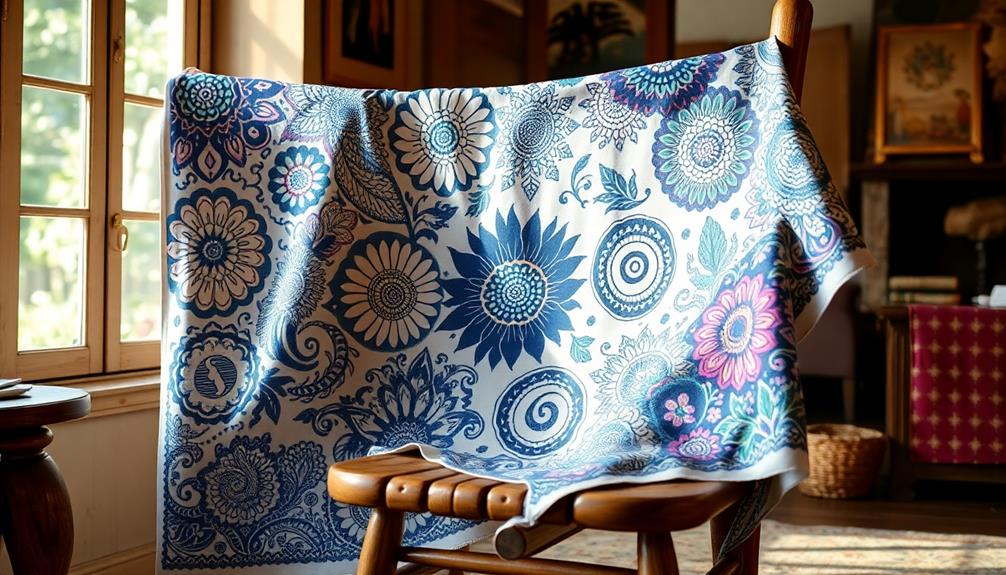
The intricate world of Batik motifs offers a fascinating glimpse into Indonesia's cultural tapestry, where each design serves a purpose beyond mere decoration. Understanding Batik means appreciating the rich symbolism woven into every pattern.
For instance, the Javanese Batik design of the Phoenix Lung-lungan represents interdependence and mutual support, reflecting deep social values. The Kawung motif, with its intersecting squares and circles, historically signified prestige, reserved for royalty, illustrating the cultural hierarchy in Javanese society. Additionally, many Batik patterns, much like the Indonesian decor masks, showcase intricate designs that celebrate traditional craftsmanship.
Furthermore, non-geometric patterns often symbolize regeneration and fertility, showcasing diverse flora and fauna that carry spiritual significance. These motifs connect the wearer to their cultural heritage, transforming them from simple decorative elements into powerful narrative tools.
Take the Udan Liris motif, translating to "light rain," which features diagonal rows of narrow bands symbolizing natural phenomena. This highlights how Batik art can reflect environmental themes as well.
Batik Production Techniques

Understanding the artistry behind Batik motifs naturally leads to exploring the various production techniques that bring these designs to life. The three main Batik production techniques are Batik Tulis, Batik Cap, and Batik Cetak. Each method showcases the cultural heritage of Batik while varying in quality and artistic value.
| Technique | Description |
|---|---|
| Batik Tulis | Hand-drawn designs using a canting tool and wax, allowing for intricate designs that can take months. |
| Batik Cap | Utilizes copper stamps for quicker wax application, maintaining artistic value with efficient production. |
| Batik Cetak | Printed textiles that are more accessible but sacrifice some traditional craftsmanship. |
| Natural Dyes | Traditionally derived from plants like Indigofera and Soga tree, offering rich, vibrant colors. |
While Batik Tulis is often regarded as the highest quality due to the skill involved, Batik Cap and Batik Cetak offer their own unique appeal. Embracing these Batik production techniques not only enhances your home decor but also celebrates the intricate designs and artistic value that reflect a rich cultural heritage.
Modern Interpretations of Batik
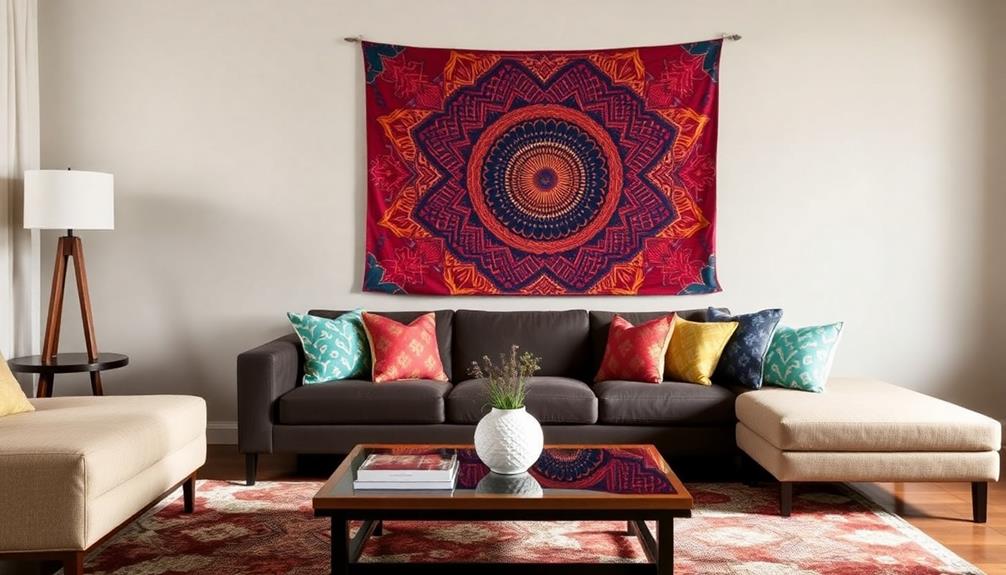
Modern interpretations of Batik have emerged as a vibrant blend of traditional artistry and contemporary design, capturing the attention of a global audience. Designers are now embracing modern Batik by infusing contemporary batik elements with traditional artistic techniques, appealing to younger consumers.
This fusion of traditional patterns and modern aesthetics enhances the visibility of Batik textiles in the home decor market, making it a popular choice for items like Indonesian decorative pillows, which add comfort and cultural heritage to living spaces.
Through innovative ways, designers are expanding Batik's application beyond clothing, incorporating it into accessories and interior decor. Digital printing technology allows for rapid production, enabling designers to experiment with batik designs and customize them to meet diverse consumer preferences.
As a result, unique collections resonate with current fashion trends while preserving the cultural significance of this ancient art form.
Collaborations between artisans and modern designers have also emerged, creating collections that tell contemporary stories and reflect societal values, all while honoring Batik's rich heritage.
Incorporating Batik in Home Decor

Incorporating Batik into your home decor not only highlights vibrant colors and intricate patterns but also connects your space to the rich cultural heritage of Indonesia. The unique artistry of Batik textiles complements other cultural elements, such as Indonesian decor masks, allowing for a cohesive and meaningful decor theme.
You can easily transform your environment by using Batik textiles in various decor items like cushion covers, table runners, and wall hangings. These pieces serve as visually appealing elements that blend traditional motifs with modern aesthetics, making them perfect conversation starters.
By choosing Batik, you support local artisans and promote sustainable practices within the textile industry. Each design often carries nature symbolism, contributing to a calming atmosphere that enriches your home.
Integrating Batik elements, such as curtains or upholstery, allows you to embrace the storytelling aspect of decor, as each piece reflects unique narratives tied to Indonesian heritage.
Whether you opt for bold patterns or subtle designs, Batik can enhance your home decor while celebrating cultural significance. You'll not only enjoy the beauty of these intricate patterns but also appreciate the deeper meanings behind them, connecting your living space to a rich history and artistic expression.
Frequently Asked Questions
What Are the Elements of Batik Design?
Batik design elements include intricate motifs, natural themes, and symbolic colors. You'll notice patterns like the Kawung and Udan Liris, each representing deeper meanings rooted in culture, spirituality, and social values throughout Indonesia's rich artistic heritage.
What Is the Cultural Significance of Batik?
Batik's cultural significance is like an intricate tapestry, weaving together Indonesia's rich history and diverse identities. Each motif you see tells a story, reflecting community ties, social status, and natural beauty, enriching your understanding of its heritage.
What Are the 5 Major Types of Batik Design Motif?
You'll find five major batik motifs: Ceplok with geometric shapes, Udan Liris symbolizing rain, Kawung representing prestige, Tambal Miring reflecting Buddhist influence, and Non-Geometric patterns showcasing nature's beauty and spiritual significance.
What Is Batik Design?
Batik design's a traditional Indonesian textile art, created using wax-resist dyeing techniques. You'll find intricate patterns that reflect cultural stories and values, showcasing themes like nature, spirituality, and social significance in every piece.
Conclusion
By now, you've discovered the rich history and vibrant motifs of batik, along with the intricate techniques that bring them to life. Imagine how these stunning designs could transform your space. Picture the warm embrace of colors and patterns that tell a story, inviting intrigue and conversation. As you consider incorporating batik into your home decor, ask yourself: which piece will you choose to make your environment uniquely yours? The perfect touch awaits—will you seize it?
Home Decor
How to Use Batik to Create a Chic and Culturally Rich Home
Open the door to a chic and culturally rich home by exploring the vibrant world of batik—discover how to transform your space with this traditional art.

To create a chic and culturally rich home, start by incorporating batik fabrics into your decor. Use vibrant cushion covers to add warmth and visual appeal to your living spaces. A stunning batik table runner can elevate your dining experience during gatherings. Consider hanging batik wall art to showcase the intricate designs and rich heritage of this traditional craft. You might even explore DIY batik projects for unique, personalized pieces. By blending batik into your home, you celebrate artistry and culture while making a stylish statement. There are plenty of creative ideas waiting for you to discover!
Key Takeaways
- Incorporate batik fabric in cushion covers and curtains to add vibrant colors and cultural patterns to your living space.
- Use batik table runners and placemats to create a festive atmosphere during family gatherings and enhance dining experiences.
- Create DIY batik wall art or home accessories to personalize your decor while appreciating traditional craftsmanship and cultural heritage.
- Showcase batik patterns in everyday items like storage baskets and lampshades to elevate your home's aesthetic with artisanal designs.
- Support local artisans by choosing sustainable batik textiles, fostering fair trade and preserving cultural heritage while enhancing your home.
Understanding Batik Fabric

Batik fabric is a unique textile that showcases the beauty of intricate designs created through a wax-resist dyeing process. This technique involves applying hot wax to fabric, which serves as a barrier against dye, allowing for the creation of detailed patterns.
Traditionally, batik fabric consists of cotton, but you may also find contemporary pieces made from silk and rayon that enhance texture and appearance. The vibrant artistry of batik reflects rich Indonesian culture, making it a perfect complement to Indonesian Decor Masks that celebrate local traditions.
The term "batik" comes from the Javanese word "bathikan," meaning mark-making, highlighting the art's emphasis on detailed design. In the past, artists hand-drew designs using a canting tool, while modern methods often use copper stamps for efficiency. This evolution has led to a variety of traditional patterns that reflect cultural significance, allowing you to appreciate the craftsmanship behind each piece.
Additionally, batik fabric goes through multiple dye baths, which encourages experimentation and results in vibrant colors that can liven up any space.
Historical Significance of Batik

The rich tradition of batik is deeply rooted in Indonesia's history, particularly on the island of Java, where its origins can be traced back over 2000 years.
This ancient art form reflects the spiritual, cultural, and social aspects of Indonesian culture, much like the intricate designs found in Indonesian decor masks that also embody the nation's heritage.
The name "batik" comes from the Javanese word "ambatik," meaning "cloth with little dots," highlighting its unique wax-resist dyeing technique.
Batik designs are more than just beautiful patterns; they carry deep meanings and have evolved over time.
Here are a few key points about batik's historical significance:
- Symbolic Meanings: Traditional batik patterns often represent spiritual beliefs or cultural stories.
- Social Status: Specific designs can indicate one's social standing within Indonesian society.
- Ceremonial Use: Batik plays an essential role in rituals and celebrations, showcasing its cultural importance.
- Global Influence: While it originates in Indonesia, batik has inspired various adaptations in countries like India and those in Africa.
Types of Batik Techniques

When exploring batik for your home decor, you'll encounter a variety of techniques that each bring something unique to the table.
Traditional methods like Batik Tulis and Batik Cap offer intricate designs and uniform patterns, making them ideal for incorporating into Indonesian Decorative Pillows for a vibrant accent in your living space.
Meanwhile, modern innovations such as Batik Lukis introduce bold, experimental styles that can serve as stunning wall art or statement pieces.
Understanding these techniques will help you choose the perfect batik pieces to enhance your space.
Traditional Batik Techniques
In exploring the rich world of batik, you'll encounter several traditional techniques that each offer distinct characteristics and aesthetic qualities.
Understanding these methods not only enhances your appreciation for batik patterns but also helps you choose the right style for your home decor. Incorporating elements of batik into your space can seamlessly blend with traditional Indonesian style home decor, emphasizing natural materials and cultural heritage.
1. Batik Tulis: This hand-drawn technique uses a canting tool to create intricate designs, resulting in unique, one-of-a-kind pieces.
It's labor-intensive and often the most expensive form of traditional batik.
2. Batik Cap: Utilizing copper stamps, this method produces uniform patterns quickly.
It's more affordable than Batik Tulis and retains the traditional aesthetics, making it popular for mass production.
3. Batik Pesisir: Originating from coastal areas, this style features vibrant colors and foreign motifs, reflecting a blend of local and international influences.
It beautifully showcases the rich cultural heritage of batik.
4. Batik Belanda: This Dutch-inspired style merges Western designs with Javanese tradition, creating a unique fusion in batik patterns.
It gained popularity during the colonial period, offering a distinctive artistic perspective.
Modern Batik Innovations
Modern batik innovations breathe new life into this ancient art form, showcasing versatility and creativity that resonate with contemporary aesthetics.
These techniques not only reflect the rich cultural heritage of Indonesia but also enhance the aesthetic appeal of home decor, similar to the enchanting importance of Indonesian decor masks. You can explore various techniques to incorporate unique batik designs into your home decor.
Batik Tulis involves hand-drawing intricate patterns with a canting tool, resulting in one-of-a-kind pieces that carry a cultural flair. While it's labor-intensive and often pricier, the artistry is unparalleled.
For something more affordable, consider Batik Cap, which uses copper stamps to create uniform designs quickly. It retains traditional elements while making batik accessible.
If you're seeking artistic expression, Batik Lukis allows you to paint directly on undyed fabric, leading to modern designs that diverge from traditional motifs.
Meanwhile, Batik Pesisir features vibrant colors and influences from coastal trade, fusing various cultural styles into its designs.
Incorporating Batik in Home Decor
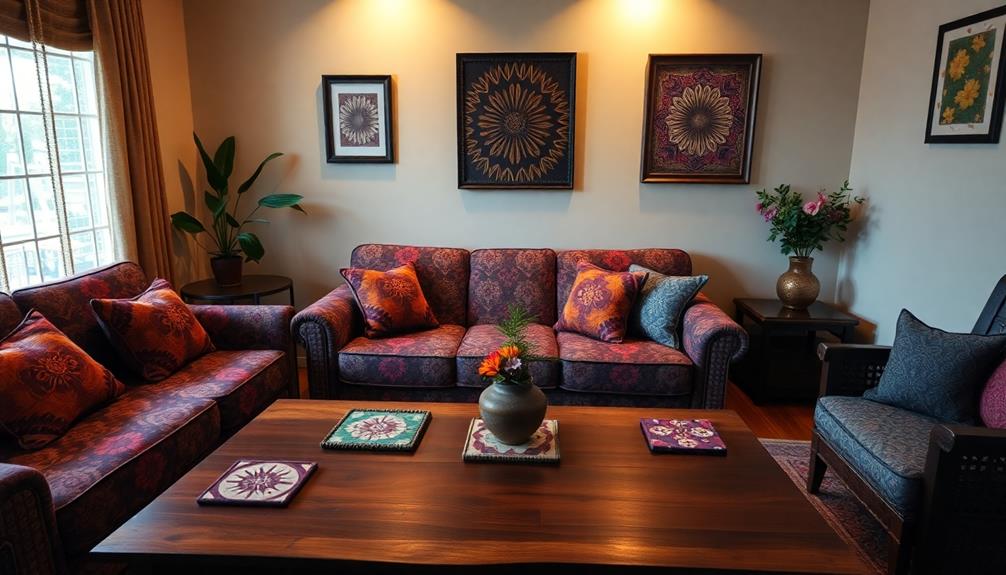
Batik's vibrant colors and intricate patterns can breathe new life into your home decor. By incorporating these unique designs, you can infuse your space with cultural flair that celebrates the rich heritage of this textile art.
Additionally, consider blending batik with other cultural elements, such as incorporating traditional Indonesian wedding decor ideas to enhance your home's aesthetic. Here are four ideas to help you get started:
- Cushion Covers: Use batik fabric for cushion covers to add pops of vibrant colors and intricate patterns to your living room. They enhance the visual appeal and create a cozy atmosphere.
- Table Runners: Incorporate batik table runners into your dining settings. They not only provide a cultural touch but also create a festive atmosphere during gatherings with family and friends.
- Curtains: Batik-patterned curtains can serve as striking focal points in any room. They bring warmth and elegance while highlighting the beauty of this traditional art form.
- Wall Hangings: Transform blank walls into enchanting displays with batik wall hangings or framed pieces. These artworks celebrate the historical significance of batik, turning your home into a gallery of cultural artistry.
DIY Batik Projects

Creating your own batik projects opens up a world of artistic expression and personalization for your home. You can start by making DIY batik wall art. Apply hot wax to fabric or canvas and dye it with natural dyes to achieve unique patterns that reflect cultural heritage, similar to the intricate designs found in traditional Indonesian housing.
This creative process not only beautifies your space but also connects you to traditional artistry.
Consider crafting table runners or placemats using vibrant colors and intricate designs. These pieces can enhance your dining experiences while celebrating the rich history of batik.
For a cozy touch, sew cushion covers from batik fabric scraps. This way, you can easily change your living space's aesthetics with the seasons.
Don't stop there! Transform everyday items like storage baskets or lampshades by incorporating batik fabric. This adds a personal flair that showcases craftsmanship.
Finally, experiment with batik painting on undyed fabric for a modern artistic twist. Frame your creations or use them in home decor to infuse your space with unique patterns that tell a story.
Immerse yourself in these DIY batik projects and embrace the beauty of cultural symbolism in architecture in your home!
Batik in Fashion Accessories

Batik accessories offer a vibrant way to elevate your outfits while celebrating cultural heritage.
With their intricate patterns and bold hues, these items can transform your everyday life into a fashion statement. Incorporating batik into your home decor can also enhance your living space, especially when combined with the unique styles found in Bali's interior shops, such as tropical home decor.
Here are four batik accessories you should consider incorporating into your wardrobe:
- Batik Scarves: Lightweight and versatile, they add a splash of color to any outfit and can be styled in numerous ways.
- Batik Bags: From tote bags to clutches, these bags showcase vibrant colors while providing a practical solution for your daily needs.
- Batik Jewelry: Look for fabric-wrapped designs that add artistry and a pop of color, allowing you to wear a piece of culture with pride.
- Batik Face Masks: Protect yourself while making a statement. These masks not only serve a functional purpose but also express your individuality and appreciation for traditional craftsmanship.
Batik Table Settings
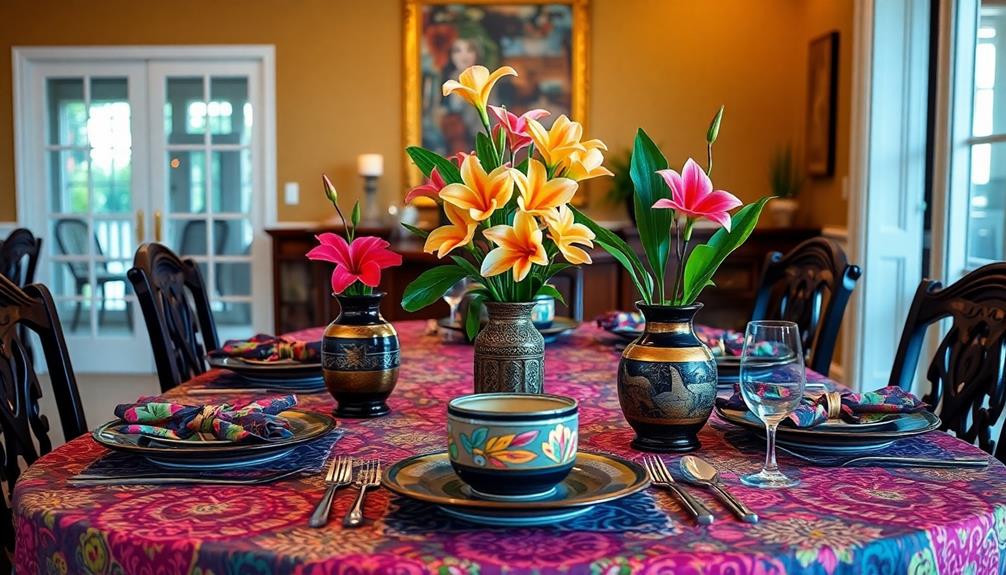
Incorporating batik into your home decor can extend beyond fashion accessories to create stunning table settings that impress your guests. Start with a batik table runner, which introduces vibrant colors and intricate patterns that enhance the visual appeal of your dining table during meals and gatherings.
Pair this with batik napkins that complement your dinnerware, adding a unique cultural flair that elevates the dining experience. To enhance the ambiance further, consider using tropical villa plans that focus on open spaces and natural light, creating a serene atmosphere for your dining area.
Don't forget about coasters! Create them from batik fabric squares to protect your surfaces while showcasing beautiful designs that reflect your appreciation for craftsmanship.
For an even more cohesive look, design placemats featuring batik motifs. This addition adds visual interest, making every meal feel special.
To truly enhance festive occasions, consider using a combination of batik elements. Mixing table runners, napkins, and coasters creates a chic and culturally rich dining atmosphere that your guests will love.
Sustainable Practices With Batik
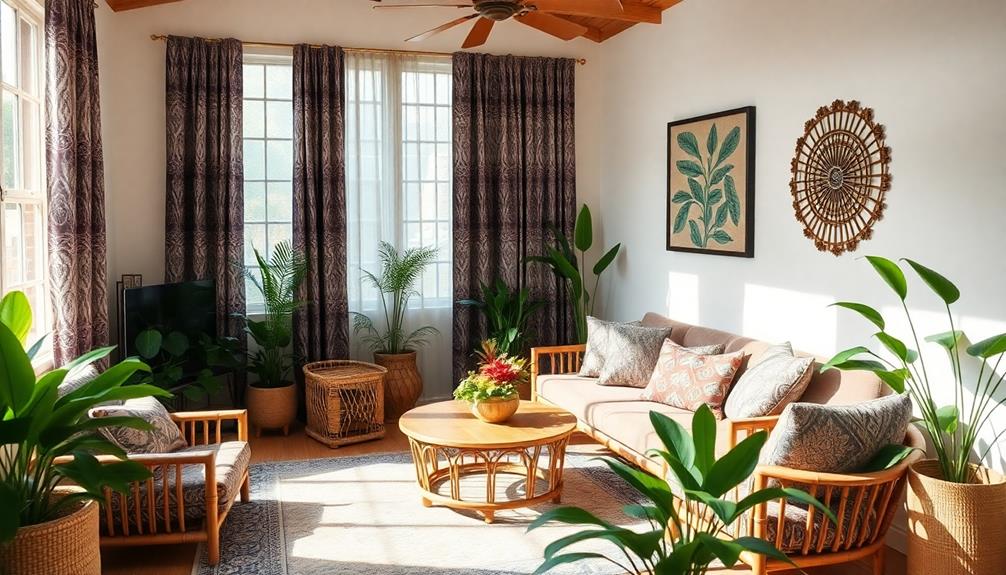
Many people mightn't realize that batik textiles are a sustainable choice for home decor. By choosing batik, you not only enhance your space with unique craftsmanship but also support eco-friendly practices that benefit the environment and local communities.
Batik can beautifully complement Balinese design characteristics, as it incorporates traditional craftsmanship and promotes a connection to nature through its vibrant patterns.
Here are some sustainable practices associated with batik:
- Natural Dyes: Batik production often uses dyes sourced from plants like indigo and cochineal, reducing reliance on harmful synthetic chemicals.
- Wax-Resist Technique: Artisans employ traditional wax-resist dyeing methods, allowing the same fabric to be dyed multiple times, which minimizes waste.
- Support Local Artisans: Investing in batik supports local artisans and communities, fostering fair trade and preserving cultural heritage through their craftsmanship.
- Durable Textiles: Batik textiles are known for their durability and timeless appeal, reducing the need for frequent replacements and promoting sustainable consumerism.
Future Trends in Batik Design

As you explore the future of batik design, you'll notice an exciting shift towards eco-friendly innovations that use natural dyes, keeping the craft sustainable and vibrant.
The blending of cultural elements with modern artistic interpretations is creating unique decor pieces that resonate with contemporary tastes.
Plus, collaborations between traditional artisans and modern designers are breathing new life into batik, making it a staple in home decor trends.
Eco-Friendly Design Innovations
Embracing eco-friendly design innovations in batik is transforming the way we think about textile production. As the demand for sustainable practices grows, designers are turning to natural dyes sourced from plants, reducing reliance on synthetic colorants. This shift not only promotes sustainability but also revitalizes this beautiful art form.
Here are four key innovations shaping the future of batik:
- Natural Dyes: Many designers are utilizing plant-based dyes, creating vibrant colors while minimizing environmental impact.
- Organic and Recycled Materials: Contemporary batik is incorporating materials that are both organic and recycled, aligning with modern fashion trends focused on sustainability.
- Advanced Techniques: Emerging creators are experimenting with batik methods, producing unique pieces that cater to eco-aware consumers.
- Digital Printing: The integration of technology allows for reduced waste and enhanced precision, maintaining traditional craftsmanship while modernizing the process.
These innovations not only enhance the aesthetic appeal of batik but also guarantee that it contributes to a sustainable future, making it a perfect choice for your chic and culturally rich home.
Cultural Fusion in Trends
Fusing traditional batik techniques with contemporary design elements is reshaping the way you can incorporate this art form into your home decor. Designers are creatively combining vibrant colors and intricate patterns to bring a unique cultural flair to modern living spaces. This trend embraces artisanal craftsmanship, appealing to those who value authenticity and storytelling in their decor choices.
As batik evolves, you'll find it featured in high-profile collections, emphasizing its relevance in both fashion and interior design. The integration of eco-conscious materials further enhances its appeal, allowing you to make sustainable choices while adding a touch of elegance to your home.
| Traditional Elements | Contemporary Design | Cultural Impact |
|---|---|---|
| Intricate patterns | Minimalist aesthetics | Storytelling through art |
| Vibrant colors | Monochromatic palettes | Heritage preservation |
| Artisanal craftsmanship | Mass production options | Ethical consumerism |
Modern Artistic Interpretations
Modern batik design is witnessing a vibrant transformation, as countless artists explore innovative interpretations that blend tradition with contemporary flair.
These modern artistic interpretations breathe new life into intricate designs, appealing to younger audiences while honoring cultural heritage.
Here are some exciting trends you can look out for:
- Abstract Patterns: Contemporary batik often embraces abstract designs, merging traditional motifs with fresh aesthetics.
- Eco-Conscious Practices: Many designers use natural dyes sourced from plants, promoting sustainability and environmental responsibility in their creations.
- Digital Printing: The rise of digital technology allows for quicker reproduction of intricate batik designs, making them accessible without losing the essence of craftsmanship.
- Cultural Fusion: Batik is increasingly blended with other textile arts and influences, resulting in diverse designs that celebrate global craftsmanship, enriching your decor with cultural flair.
Frequently Asked Questions
What Is the Cultural Significance of Batik?
Batik's cultural significance lies in its deep-rooted history and symbolism. You'll find it represents heritage, identity, and values across various cultures, showcasing intricate designs that convey stories of bravery, prosperity, and familial bonds through generations.
What Are the 5 Major Types of Batik Design?
Imagine wrapping yourself in a vibrant Batik Tulis shawl. You'll discover five major types: Batik Tulis, Batik Cap, Batik Lukis, Batik Pesisir, and Batik Belanda, each offering unique cultural stories and artistic expressions.
What Is Batik in Cultural and Creative Art?
Batik's a vibrant textile art form that blends cultural heritage with creativity. You explore intricate designs, each telling a unique story. Its wax-resist dyeing technique showcases craftsmanship, making it a beautiful, meaningful addition to any collection.
What Does Batik Symbolize?
Batik symbolizes cultural identity and heritage, reflecting historical narratives and social status. Each pattern carries unique meanings, connecting you to traditions and stories, while showcasing adaptability across cultures, reinforcing the significance of lineage and artistic expression.
Conclusion
Incorporating batik into your home decor not only enhances your space with vibrant patterns but also connects you to a rich cultural heritage. Did you know that batik has been recognized by UNESCO as an Intangible Cultural Heritage of Humanity? This highlights its global significance and artistry. By embracing batik in your decor, you're not just beautifying your home; you're also celebrating a timeless art form that's been cherished for centuries. Make your space chic and culturally rich!
-
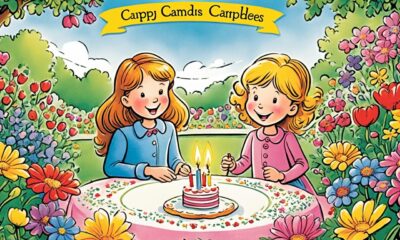
 Mom3 months ago
Mom3 months agoHeartfelt Poems for Your Daughter’s Birthday
-

 Mom3 months ago
Mom3 months agoHappy Birthday Religious Wishes and Blessings
-

 Mom3 months ago
Mom3 months agoHappy 65th Birthday: Celebrate Your Special Day!
-

 Mom3 months ago
Mom3 months agoHappy Birthday in Heaven from Daughter: Remembering You
-

 Mom3 months ago
Mom3 months agoCelebrating 60 Years: Happy 60th Birthday Wishes
-

 Mom3 months ago
Mom3 months ago62nd Birthday Quotes for Mom: Celebrate Her Special Day
-

 Mom3 months ago
Mom3 months agoCelebrate a Joyous Happy 70th Birthday Milestone!
-

 Mom3 months ago
Mom3 months agoHappy 61st Birthday: Celebrate This Special Milestone


















